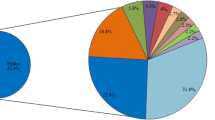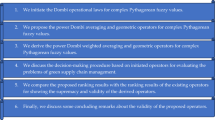Abstract
In this study, a factorial-based fuzzy-stochastic dynamic programming (FFS-DP) method is developed for tackling multiple uncertainties including fuzziness, randomness and their interaction in reservoir operation management (ROM). FFS-DP is framed on the integration of stochastic dynamic programming, fuzzy-Markov chain, vertex analysis and factorial analysis techniques. It can not only deal with the conventional optimization problem for reflecting dynamic and uncertain features in ROM, but also obtain detailed effects of uncertain parameters and their interactions on the system performance. The developed method is applied to a case study of a reservoir operation system, where the local authority is in charge of allocating relative scant water to the downstream municipality. The results obtained can help the local authority identify desired water release policies under uncertain system conditions. Besides, the results simultaneously indicate that significant factors and their interactions can be identified in ROM. Moreover, the results can be further analyzed for generating optimal parameter inputs to obtain maximized system benefits.









Similar content being viewed by others
References
Abdelaziz FB, Masri H (2009) Multistage stochastic programming with fuzzy probability distribution. Fuzzy Set Syst 160:3239–3249
Ahmad S, Simonovic SP (2000) System dynamics modeling of reservoir operations for flood management. J Comput Civ Eng 14(3):190–198
Antony J (2003) Design of experiments for engineers and scientist. Butterworth-Heinemann, New York
Box GEP, Hunter WG, Hunter JS (1978) Statistics for experimenters. Wiley, New York
Cervellera C, Chen VCP, Wen AH (2006) Optimization of a large-scale water reservoir network by stochastic dynamic programming with efficient state space discretization. Eur J Oper Res 171(3):1139–1151
Chang FJ, Hui SC, Chen YC (2002) Reservoir operation using grey fuzzy stochastic dynamic programming. Hydrol Processes 16:2395–2408
Chen SJ, Hwang CL (1992) Fuzzy multiple attribute decision making: methods and applications. Springer, New York
Chowdhury P, Gomaa H, Ray AK (2011) Factorial design analysis for dye-sensitized hydrogen generation from water. Int J Hydrog Energy 36:13442–13451
Deviney FA Jr, Brown DE, Rice KC (2012) Evaluation of Bayesian estimation of a hidden continuous-time Markov chain model with application to threshold violation in water-quality indicators. J Environ Inform 19(2):70–78
Dong W, Shah HC (1987) Vertex method for computing functions of fuzzy variables. Fuzzy Set Syst 24:65–78
Dou C, Woldt W, Bogardi I, Dahab M (1997) Numerical solute transport simulation using fuzzy sets approach. J Contam Hydrol 27(1–2):107–126
Dubois D, Fargier H, Fortin J (2004) A generalized vertex method for computing with fuzzy intervals. Fuzzy Syst 1:541–546
Esogbue AO, Tbeologidu M, Guo K (1992) On the application of fuzzy sets theory to the optimal flood control problem arising in water resources systems. Fuzzy Set Syst 48:155–172
Farkas L, Moens D, Vandepitte D, Desmet W (2008) Application of fuzzy numerical techniques for product performance analysis in the conceptual and preliminary design stage. Comput Struct 86(10):1061–1079
Fenton N, Wang W (2006) Risk and confidence analysis for fuzzy multicriteria decision making. Knowl-Based Syst 19(6):430–437
Fu DZ, Li YP, Huang GH (2011) A fuzzy-Markov-chain-based analysis method for reservoir operation. Stoch Env Res Risk A 26(3):375–391
Galelli S, Soncini-Sessa R (2010) Combining metamodelling and stochastic dynamic programming for the design of reservoir release policies. Environ Model Softw 25(2):209–222
Ganjia A, Khalilia D, Karamouzb M (2007) Development of stochastic dynamic Nash game model for reservoir operation. I. The symmetric stochastic model with perfect information. Adv Water Resour 30(3):528–542
Hartfiel DJ, Seneta E (1994) On the theory of Markov set-chains. Adv Appl Probab 26(4):947–964
Huang Y, Chen X, Li YP, Huang GH, Liu T (2010) A fuzzy-based simulation method for modelling hydrological processes under uncertainty. Hydrol Processes 24(25):3718–3732
Jamshidi M, Heidari M (1977) Application of dynamic programming to control khuzestan water resources system. Automatica 13(3):287–293
Karakasis K, Skarlatos D, Zakinthinos T (2005) A factorial analysis for the determination of an optimal train speed with a desired ride comfort. Appl Acoust 66:1121–1134
Kaufmann A, Gupta MM (1991) Introduction to fuzzy arithmetic: theory and application. Van Nostrand Reinhold, New York
Kerachian R, Karamouz M (2007) A stochastic conflict resolution model for water quality management in reservoir–river systems. Adv Water Resour 30(4):866–882
Khan NM, Babel MS, Tingsanchali T, Clemente RS, Luong HT (2012) Reservoir optimization-simulation with a sediment evacuation model to minimize irrigation deficits. Water Resour Manag 26(11):3173–3193
Larson RE, Keckler WG (1969) Applications of dynamic programming to the control of water resource systems. Automatica 5(1):15–26
Lei L, Sun JS, Borthwick AGL, Fang Y, Ma JP, Ni JR (2013) Dynamic evaluation of intertidal wetland sediment quality in a bay system. J Environ Inform 21(1):12–22
Lenth RV (1989) Quick and easy analysis of unreplicated factorials. Technometrics 31:469–473
Li YP, Huang GH, Guo P, Yang ZF, Nie SL (2010) A dual-interval vertex analysis method and its application to environmental decision making under uncertainty. Eur J Oper Res 200(2):536–550
Li YP, Huang GH, Chen X (2011a) Planning regional energy system in association with greenhouse gas mitigation under uncertainty. Appl Energy 88(3):599–611
Li YP, Huang GH, Nie SL (2011b) Optimization of regional economic and environmental systems under fuzzy and random uncertainties. J Environ Manage 92:2010–2020
Loucks DP, Stedinger JR, Haith DAH (1981) Water resources systems planning and analysis. Prentice–Hall, Engelwood Cliffs
Malandrino A, Planell JA, Lacroix D (2009) Statistical factorial analysis on the poroelastic material properties sensitivity of the lumbar intervertebral disc under compression, flexion and axial rotation. J Biomech 42:2780–2788
Montgomery DC, Runger GC (2003) Applied statistics and probability for engineers, 3rd edn. Wiley, New York
Mousavi SJ, Mahdizadeh K, Afshar A (2004) A stochastic dynamic programming model with fuzzy storage states for reservoir operations. Adv Water Resour 27(11):1105–1110
Mousavi SJ, Ponnambalam K, Karray F (2007) Inferring operating rules for reservoir operations using fuzzy regression and ANFIS. Fuzzy Set Syst 158(10):1064–1082
Neter J, Wasserman W, Kutner MH (1985) Applied linear statistical models, 2nd edn. Irwin
Pereira MVF (1989) Optimal stochastic operations scheduling of large hydroelectric systems. Int J Electr Power Energy Syst 11(3):161–169
Pokhrel D, Viraraghvan T (2006) Arsenic removal from aqueous solution by iron oxide coated fungal biomass: a factorial design analysis. Water Air Soil Pollut 173:19–208
Qin XS, Huang GH (2009) An inexact chance-constrained quadratic programming model for stream water quality management. Water Resour Manag 23(4):661–695
Reis LFR, Walters GA, Savic D, Chaudhry FH (2005) Multi-reservoir operation planning using hybrid genetic algorithm and linear programming (GA-LP): An alternative stochastic approach. Water Resour Manag 19(6):831–848
Rekow ED, Harsono M, Janal M, Thompson VP, Zhang G (2006) Factorial analysis of variables influencing stress in all-ceramic crowns. Dent Mater 22:125–132
Rivera JF, Ferrero RW (1993) The influence of considering the temporal correlation of the inflows in the optimal operation program calculated through stochastic dynamic programming. Electr Power Syst Res 28(1):19–25
Safa Y, Bhatti HN (2011) Adsorptive removal of direct textile dyes by low cost agricultural waste: Application of factorial design analysis. Chem Eng J 167:35–41
Stedinger JR, Sule BF, Loucks DP (1984) Stochastic dynamic programming models for reservoir operation optimization. Water Resour Res 20(11):1499–1505
Suman B, Hoda N, Jha S (2010) Orthogonal simulated annealing for multiobjective optimization. Comput Chem Eng 34:1618–1631
Tashtoush GM, Al-Widyan MI, Albatayneh AM (2007) Factorial analysis of diesel engine performance using different types of biofuels. J Environ Manage 84:401–411
Tilmant A, Faouzi EH, Vanclooster M (2002) Optimal operation of multipurpose reservoirs using flexible stochastic dynamic programming. Appl Soft Comput 2(1):61–74
Torchio MF, Santarelli MG, Nicali A (2005) Experimental analysis of the CHP performance of a PEMFC stack by a 24 factorial design. J Power Sources 149:33–43
Winer BJ (1971) Statistical principles in experimental design, 2nd edn. McGraw-Hill
Zimmermann HJ (1996) Fuzzy set theory and its applications, 3rd edn. Norwell, MA, USA
Acknowledgments
This research was supported by the National Natural Science Foundation for Distinguished Young Scholar (Grant No. 51225904) and the Natural Sciences Foundation of China (Grant Nos. 51379075 and 51190095). The authors are grateful to the editors and the anonymous reviewers for their insightful comments and helpful suggestions.
Author information
Authors and Affiliations
Corresponding author
Rights and permissions
About this article
Cite this article
Fu, D.Z., Li, Y.P. & Huang, G.H. A Factorial-based Dynamic Analysis Method for Reservoir Operation Under Fuzzy-stochastic Uncertainties. Water Resour Manage 27, 4591–4610 (2013). https://doi.org/10.1007/s11269-013-0429-6
Received:
Accepted:
Published:
Issue Date:
DOI: https://doi.org/10.1007/s11269-013-0429-6




